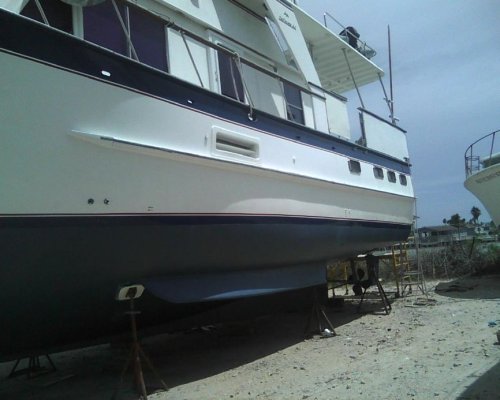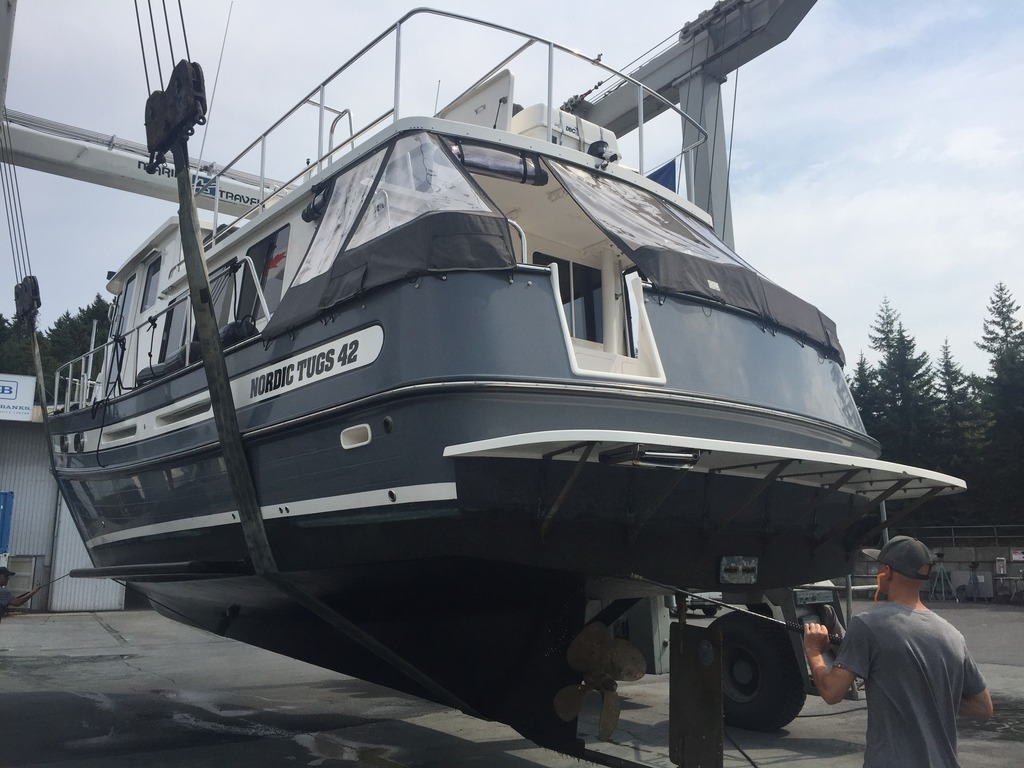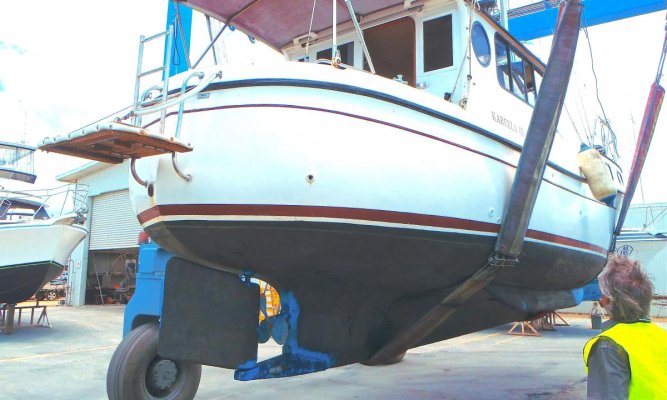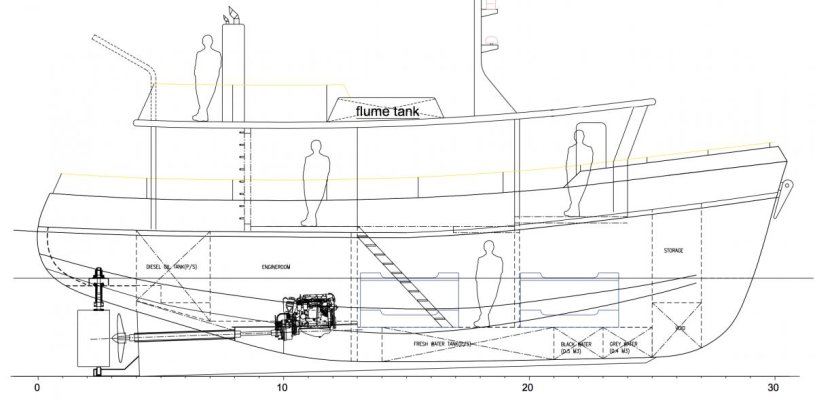You are using an out of date browser. It may not display this or other websites correctly.
You should upgrade or use an alternative browser.
You should upgrade or use an alternative browser.
Static Fins
- Thread starter jacks88
- Start date
The friendliest place on the web for anyone who enjoys boating.
If you have answers, please help by responding to the unanswered posts.
If you have answers, please help by responding to the unanswered posts.
Diesel Duck
Senior Member
Here is an excerpt from Kasten Marine's web site about bilge keels (static fins):
* Fixed "Bilge" Keels: Long, low aspect ratio bilge keels, per research published in Marine Technology, have been observed to offer possible roll reductions on the order of 35% to 55%. Vessel speed is not important to roll damping. There is some added frictional resistance due to increased wetted surface area. If proportioned correctly, bilge keels offer enhanced directional stability. Very common as a retro-fit. Relatively inexpensive. Relatively simple to build.
Lot's of additional information on the topic... google "bilge keels".
* Fixed "Bilge" Keels: Long, low aspect ratio bilge keels, per research published in Marine Technology, have been observed to offer possible roll reductions on the order of 35% to 55%. Vessel speed is not important to roll damping. There is some added frictional resistance due to increased wetted surface area. If proportioned correctly, bilge keels offer enhanced directional stability. Very common as a retro-fit. Relatively inexpensive. Relatively simple to build.
Lot's of additional information on the topic... google "bilge keels".
Last edited:
Nomad Willy
Guru
From what I have read 35 to 50% is very optimistic. Probably closer to 15 to 20%. Just going by what Iv'e read though. I hear a steadying sail is considerably more effective.
For hauling just put "Lift Here" in the appropraite places next time you're hauled. I keep forgetting to do that. Would definitely not want a lifting strap over the fin.
For hauling just put "Lift Here" in the appropraite places next time you're hauled. I keep forgetting to do that. Would definitely not want a lifting strap over the fin.
Capt.Bill11
Guru
From what I have read 35 to 50% is very optimistic. Probably closer to 15 to 20%. Just going by what Iv'e read though. I hear a steadying sail is considerably more effective.
For hauling just put "Lift Here" in the appropraite places next time you're hauled. I keep forgetting to do that. Would definitely not want a lifting strap over the fin.
I'd say there is no way to avoid straps going across bilge keels. Unless they were mounted close to the keel and/or they were very short.
MurrayM
Guru
Must be the tryptophan, but has anybody used daggerboards in a trawler?
Just doodling here, but you could have slots in the hull through which the daggerboards could be dropped or pulled up, and have enclosed compartments inside the hull to above the waterline.
Smooth water, pull them up...snotty weather, drop them down. Would be prudent to make them of a break away material...
Just doodling here, but you could have slots in the hull through which the daggerboards could be dropped or pulled up, and have enclosed compartments inside the hull to above the waterline.
Smooth water, pull them up...snotty weather, drop them down. Would be prudent to make them of a break away material...
Xsbank
Guru
- Joined
- Sep 7, 2013
- Messages
- 3,791
- Location
- Canada
- Vessel Name
- Gwaii Haanas
- Vessel Make
- Custom Aluminum 52
Those in the picture are bilge keels, I believe there are also roll chocks or rolling chocks you can install.
Interesting thought Murray, like roll chocks, great for gathering crab pots and for lovely thick beds of mussels. Yours would avoid the mussels...
Interesting thought Murray, like roll chocks, great for gathering crab pots and for lovely thick beds of mussels. Yours would avoid the mussels...
Nomad Willy
Guru
Murray,
You should be a designer.
I'll bet they would be as much trouble as center board trunks.
Would likely be a problem finding space in the hull for them too. Optimally they would not be vertical but splayed out 15 or 20 degrees. Fuel tanks and other in hull things may need to take on another shape.
Don't know but could they promote capsizing in beam seas? I was once in a situation where the ability to slide sideways down the face of a large beam sea may have saved the day.
You should be a designer.
I'll bet they would be as much trouble as center board trunks.
Would likely be a problem finding space in the hull for them too. Optimally they would not be vertical but splayed out 15 or 20 degrees. Fuel tanks and other in hull things may need to take on another shape.
Don't know but could they promote capsizing in beam seas? I was once in a situation where the ability to slide sideways down the face of a large beam sea may have saved the day.
MurrayM
Guru
Eric; Yeah, well, the tryptophan obviously excited the designer component in my brain. Now just need to find the compound to massage the salesman/advertising guru part that will have the gullible (ahem...educated) responding to all my Passagemaker full page ads 
X...crab pots not a problem here which is a function of mind boggling amounts of directions to explore and a low population base
X...crab pots not a problem here which is a function of mind boggling amounts of directions to explore and a low population base

Northern Spy
Guru
- Joined
- Feb 5, 2012
- Messages
- 4,075
- Location
- Canada
- Vessel Name
- Northern Spy
- Vessel Make
- Nordic Tug 26
Leeboards.
bcam
Senior Member
We have static fins on our Nordic Tug. They extend horizontally about 10". So far, they seem to work. We haven't experienced any heavy weather though.
I am having problems posting pictures.
I am having problems posting pictures.
AusCan
Guru
- Joined
- Jul 15, 2012
- Messages
- 3,218
- Location
- Australia
- Vessel Name
- Kokanee
- Vessel Make
- Cuddles 30 Pilot House Motor Sailer
My boat has bilge keels which are about 15 ft long and protrude about 10". They are fairly solid being about 3" thick. Hauling the boat is done with the straps fore and aft of the fins.
I can't compare their effectiveness directly as I haven't been on the same boat without the bilge keels, although the earlier models did not have them. Still, my boat is very rolly in a beam sea due to the rounded bilge hull design.
According to this article (originally posted by FF) the effectiveness of bilge keels is best while the boat is at anchor, and they are considerably less effective as speed increases. (see http://onlinelibrary.wiley.com/doi/1...10.00298.x/pdf )
My personal experience concurs with this.
As Eric stated, steadying sails have a much greater roll reduction effect (if sized correctly).
I can't compare their effectiveness directly as I haven't been on the same boat without the bilge keels, although the earlier models did not have them. Still, my boat is very rolly in a beam sea due to the rounded bilge hull design.
According to this article (originally posted by FF) the effectiveness of bilge keels is best while the boat is at anchor, and they are considerably less effective as speed increases. (see http://onlinelibrary.wiley.com/doi/1...10.00298.x/pdf )
My personal experience concurs with this.
As Eric stated, steadying sails have a much greater roll reduction effect (if sized correctly).
Attachments
Must be the tryptophan, but has anybody used daggerboards in a trawler?
Yes, in a long skinny boat cruiser, not trawler. Avard Fuller, Chair of Fuller Brush and a tinkerer. 61 foot narrow boat that he cruised with his family for quite some time. Tad Roberts has a bit about it. It was featured in some magazines of the day.
Lightweight Motoryachts: Arielle, Marin, Marco Polo, Herreshoff,Jim Hawkins, Avard Fuller,Little Goose,William Garden
I've been investigating roll reduction for my trawler which is in design phase. According to my research and my designer's comments, they are much more effective on large ships and even so, typical roll reduction is single-digit. Basically 8%-9%.
I've decided to implement a water stabilizing flume tank.
I've decided to implement a water stabilizing flume tank.
FF
Guru
- Joined
- Oct 12, 2007
- Messages
- 22,552
Bilge keels were added to our Navy Utility 50 ,when she was outfitted for lobster service.
The boat is quiet at anchor with a mostly round bottom , in slop.
The boat is quiet at anchor with a mostly round bottom , in slop.
MurrayM
Guru
Concerning daggerboards;
Here's a quote from that article;
"His second method of stabilization was more successful: a daggerboard that extended Jim Hawkins’ draft by 5’6” (1.7m). Fuller stated in an article in Yachting magazine (June 1972) that the daggerboard damped out most of the rolling in all ordinary conditions and made the boat quite comfortable. Of course, there are structural concerns, but it would be interesting to compare drag and roll-damping between this type of daggerboard and the bilge keels or fins that have become common today."
A single daggerboard would make more sense and be less of a tripping hazard (which Eric pointed out would be a problem if you had two of them).
Yes, in a long skinny boat cruiser, not trawler. Avard Fuller, Chair of Fuller Brush and a tinkerer. 61 foot narrow boat that he cruised with his family for quite some time. Tad Roberts has a bit about it. It was featured in some magazines of the day.
Lightweight Motoryachts: Arielle, Marin, Marco Polo, Herreshoff,Jim Hawkins, Avard Fuller,Little Goose,William Garden
Here's a quote from that article;
"His second method of stabilization was more successful: a daggerboard that extended Jim Hawkins’ draft by 5’6” (1.7m). Fuller stated in an article in Yachting magazine (June 1972) that the daggerboard damped out most of the rolling in all ordinary conditions and made the boat quite comfortable. Of course, there are structural concerns, but it would be interesting to compare drag and roll-damping between this type of daggerboard and the bilge keels or fins that have become common today."
A single daggerboard would make more sense and be less of a tripping hazard (which Eric pointed out would be a problem if you had two of them).
Nomad Willy
Guru
Murray I would think that a single dagger board DB would be located best if it came right up through the engine or trans. Get far from CG and some strange motions could result.
MurrayM
Guru
Murray I would think that a single dagger board DB would be located best if it came right up through the engine or trans. Get far from CG and some strange motions could result.
Doesn't Tad's Passagemaker Lite series have smallish twins located further aft in the hull? Sounds like he's given it some thought, or at least found it "interesting".
bshanafelt
Senior Member
- Joined
- Oct 6, 2007
- Messages
- 427
- Vessel Name
- Isobel K
- Vessel Make
- 37' Custom Pilothouse
makobuilders
I've decided to implement a water stabilizing flume tank.
can you elaborate on the tank you plan to use?
I've decided to implement a water stabilizing flume tank.
can you elaborate on the tank you plan to use?
can you elaborate on the tank you plan to use?
Will be a baffled tank located on the flybridge deck. I've been in touch with three design consultants and all provide similar feedback: with my design I should conservatively expect 50% roll reduction, although 55-65% may be realized depending on conditions.
Since it will be holding around 3,000 lbs of water I plan to build it out of stainless steel and fill it with fresh water (chlorinated). Great emergency source of drinking water.
And yes, it will cut the flybridge in half, but the fore area will be dedicated to solar panels anyway, plus I'm happy with the look. Here's a quick screen shot.
Attachments
Nomad Willy
Guru
Mako,
I like your buttock line.
Looks like the PC is lower aft than fwd.
could it be considered a fish form hull?
I like your buttock line.
Looks like the PC is lower aft than fwd.
could it be considered a fish form hull?
Nomad Willy
Guru
Are you the Sherrif here 88?
I think not.
I think not.
RT Firefly
Enigma
Greetings,
Mr. Buttocks strikes again!

Mr. Buttocks strikes again!
Nomad Willy
Guru
Attack #2 today?
Mako, I like your buttock line.
I told a girl that the other day and got my face slapped
Looks like the PC is lower aft than fwd. could it be considered a fish form hull?
Good eye, Mr. Many-
She's a big, fat pig with deeply submerged bilges at 60 tons and is based on the lines of a commercial trawler.
Similar threads
- Replies
- 2
- Views
- 414
- Replies
- 46
- Views
- 4K




